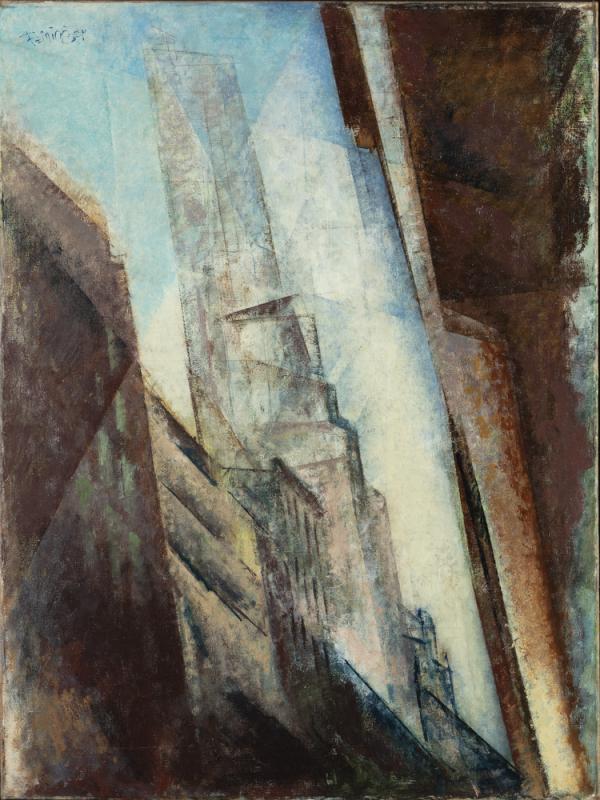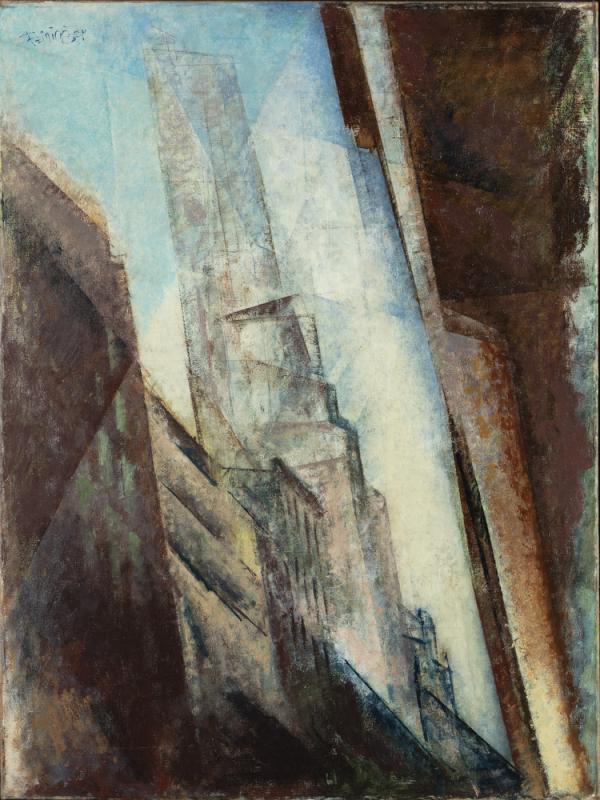Skip to main content
Manhattan II
Artist
Lyonel Feininger
(German, 1871 - 1956)
Date1940
MediumOil on canvas
DimensionsUnframed: 38 1/8 x 28 5/8 in. (96.84 x 72.71 cm)
Framed: 39 15/16 x 30 1/2 x 1 7/8 in. (101.44 x 77.47 x 4.76 cm)
Framed: 39 15/16 x 30 1/2 x 1 7/8 in. (101.44 x 77.47 x 4.76 cm)
Credit LineCollection of the Modern Art Museum of Fort Worth, Anonymous Gift
Object number1946.6
Status
Not on viewSignedu.l.c., "Feininger"
Copyright© 2020 Lyonel Feininger / Artists Rights Society (ARS), New York
Category
Label TextIn 1887, Lyonel Feininger left his hometown of New York City to study art in Germany, where he lived for nearly fifty years. From the 1910s through the early 1930s, he was a leading artist of German Expressionism and the Bauhaus. Manhattan II, 1940, which depicts a New York street scene from a close-up, ground-level perspective, belongs to a late series inspired by the skyscrapers of the artist’s native city.
In 1911, Feininger exhibited at the Salon des Indépendants in Paris. His exposure there to Cubism and the fragmented cityscapes of the Orphist painter Robert Delaunay catalyzed the development of his own kaleidoscopic, Cubist-derived language of painting. From 1919 to 1932, Feininger was a core staff member at the Bauhaus, one of the most influential schools of design and architecture until it closed in 1933 under pressure from the Nazi regime. The artist left Germany in 1936, permanently settling in New York in 1938. Feininger joined many European artists who immigrated to the US, where their work would have an immeasurable influence on the trajectory of American art.
In Manhattan II, Feininger represented the forms and spaces of the city as if seen through a prism. Characteristic of his work, the image treads a path between abstraction and representation. Crisscrossing diagonals divide the scene into overlapping planes of semi-transparent color, variously shaded from light to dark. The brighter vertical shafts suggest sunbeams bursting down between buildings, represented by the darker brown shards flanking the canvas. In the center, a skyscraper thrusts diagonally into the air. Its jutting, multifaceted form encompasses multiple viewing perspectives at once. A tribute to the city of his birth, the painting places us in the lively atmosphere of a busy New York street, where buildings tower overhead and light shines through.
In 1911, Feininger exhibited at the Salon des Indépendants in Paris. His exposure there to Cubism and the fragmented cityscapes of the Orphist painter Robert Delaunay catalyzed the development of his own kaleidoscopic, Cubist-derived language of painting. From 1919 to 1932, Feininger was a core staff member at the Bauhaus, one of the most influential schools of design and architecture until it closed in 1933 under pressure from the Nazi regime. The artist left Germany in 1936, permanently settling in New York in 1938. Feininger joined many European artists who immigrated to the US, where their work would have an immeasurable influence on the trajectory of American art.
In Manhattan II, Feininger represented the forms and spaces of the city as if seen through a prism. Characteristic of his work, the image treads a path between abstraction and representation. Crisscrossing diagonals divide the scene into overlapping planes of semi-transparent color, variously shaded from light to dark. The brighter vertical shafts suggest sunbeams bursting down between buildings, represented by the darker brown shards flanking the canvas. In the center, a skyscraper thrusts diagonally into the air. Its jutting, multifaceted form encompasses multiple viewing perspectives at once. A tribute to the city of his birth, the painting places us in the lively atmosphere of a busy New York street, where buildings tower overhead and light shines through.









